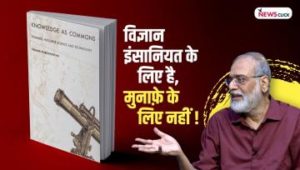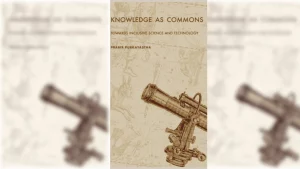When they first met in 2002 at a literary festival, Nayantara Sahgal was a veteran of more than twenty books; her debut work, the memoir Prison and Chocolate Cake, was published in 1954. Kiran Nagarkar had published his first novel, Saat Sakkam Trechalis, in Marathi in 1974, and his first work in English, Ravan and Eddie, twenty years later. Sparks didn’t fly at that first encounter. It was only in 2014, when Nagarkar wrote to Sahgal about Mistaken Identity and other books of hers that he had read, that she invited him to lunch at her home in Dehradun and thus began a correspondence that lasted until Nagarkar’s death in 2019.
Encounter with Kiran is a collection of mails that gives an intimate glimpse into the life and times of two extraordinary writers who drew strength from each other in their personal and political battles.
The following are excerpts from the book.

I recalled what Kiran had written not long after our first meeting: ‘You asked me how I could miss someone I had really met only once. That is a logical rational question. All I can say is some areas of our life and mind may not fit into this framework…I suspect despite all my cynicism I am an old-fashioned believer in either astral connections or bonds that are beyond the ken of human beings.’
Whatever the explanation for this unexpected and enriching encounter, it bears witness to two Indian writers facing the evil of their times—a time of ferocious attacks on India’s people, traditions and institutions through public killings, the imprisonment of citizens inconvenient to the ruling power, and the throttling of dissent; all this made possible by a political class and its supporting elite who have no use for our civilizational heritage, and none for human rights or human life. If horror needs description or defining, here it is. We have seen, heard and read about it as it occurred and recurred.
In such a time nothing is more heartening than the knowledge that one is not alone in one’s rage and defiance. As writers, we had this assurance from each other, and drew strength from the unending courageous protests by Indians who refused to be silenced. In the stand we ourselves took through the spoken and written word we joined forces with the fight against the unmaking of India.
[…]
Epilogue
This article, written by Kiran in 2005, and sent to me by Tulsi after his death, reveals his highly unusual, little-known and fascinating family background, leading him to reflect on how the rebel streak in his inheritance has influenced his life, his beliefs, and his literature.—Nayantara Sahgal
Looking for Gulbadan’s Kite
– Kiran Nagarkar
I never met any of my grandparents. So I ask myself, how did my paternal grandfather Balwant Nagarkar, a man who died a good thirty years before I was born, influence my life so considerably, and turn my face in the direction of the conscious and unconscious choices I would have to make for the protagonists and characters of my novels?
Yet what I know about him is precious little. He came from an orthodox Chitpavan Brahmin family from Ahmednagar. The word is that he was attached to a temple as a child to train to become a priest. He was a ‘madhukari’ , a boy who ate at certain fixed houses, a different one for every day of the week. The next thing you know about him is that he has joined Wilson College in Bombay. How? Did he have a rich patron? Did he come under the influence of some British missionary? Your guess is as good as mine. There is also some talk that he may have been asked to leave Wilson College for some paper he wrote on Christ.
The year is 1893. My grandfather goes to Chicago for the Conference of World Religions along with Swami Vivekanand. Vivekanand represents the Hindu faith, my grandfather but a minor branch of it: the Brahmo Samaj, which harked back to the monotheism of the Upanishads. From all accounts it appears that Vivekanand was the star of the day. My grandfather didn’t make it that big, but he was invited once again to another Conference of World Religions in 1903.
Questions: What made him change his faith? What motivated him? Why would he give up the certainty and security of the Hindu faith, and the livelihood from a highly respected Brahmin priesthood? Why did he risk the appalling prospect of being kicked out of his community and be persistently shunned? Why did he choose to risk ostracism by crossing the shores of India not once but twice? But he hadn’t had his fill of rebellion. After his first (or maybe it was his second) wife died, he married again, this time outside his community. He married a Jew. He had nine children with her. My father was the eldest and it was natural that he should give up his education before his matriculation and take up a job. He joined the Railways as a clerk.
I was four years old when, without realizing it, I felt the consequences of my grandfather’s actions and choices. One of my father’s childhood acquaintances had moved into Hindu Colony in Bombay where we lived. She had four daughters, the youngest one of whom, Mita, was my age. My parents would invite Mita to come to our flat to play with me. Every time she left, the parents of my closest friend who happened to live opposite would tease me about being Krishna and ask me how my ‘gopis’ were doing. It was thanks to them that I thought I was doing something that was not the done thing.
Somewhere it began to register in my mind that our family was different. We were Hindu but different from other Hindus. They worshipped the images of many gods. We had no images and we believed in only one God. What did I make of this? I’m not quite sure. All I can say with any certainty is that I began to dread going to temples, and to feel uncomfortable with the whole pantheon of three-or four-headed gods and goddesses with eight and sixteen arms. Instead of temples we went to the Prathana Samaj, the Maharashtrian version of the Brahmo Samaj to listen to a sermon interspersed with ‘abhangs’ and ‘dohas’. It would only occur to me later on that the Brahmos were as much influenced by the Protestant forms of worship that had come with British missionaries as by the Upanishads.
After four years at a Marathi school I was sent to an English medium school run by priests. I spent six years at Don Bosco, yet during all that time I did not learn the school prayer that we were supposed to recite every day. For some reason I can’t explain I mumbled some gibberish without intending any disrespect, and got away with it.
After school and then college, I found that I had begun to distance myself from both the monotheism of the Brahmos and the gods and goddesses of my Maharashtrian friends. I was well on the way to closing the doors on all religion and had begun to dislike organized religion with a passion.
And yet my novels and plays are the site of an almost obsessive concern with religion as they are of every kind of inter-, infra-, and counter-cultural conflict. Shri Krishna is at the heart of my play Bedtime Story. He appears in Ravan and Eddie, and is the kabab-mein-haddi between Meerabai and the Maharajkumar in Cuckold. Seven Sixes are Forty-three does not stray much outside the Hindu fold but it explores the cross-currents and conflicts within Hinduism itself. Ravan & Eddie is the story of two religions, two cultures running parallel but almost never meeting, seen through the eyes of two children, one a Hindu, the other a Catholic. God’s Little Soldier is a journey through both Islamic and Christian extremism.
Sometimes I think my grandfather has put a curse upon me. I cannot believe yet I cannot leave well enough alone. I keep trying to exorcise him and yet I’m not sure if along with him my muse too will vanish. Who asked him to be a maverick and break out of the happy certitudes of the Brahmin priestly class? Why could he not have continued to toll the bells of his temple in Ahmednagar clangorously so I would hear, not have to confront the terrible dilemmas of our self-righteous violence, of Ram and Rahim, the touchables and untouchables, of Osama bin Laden and of Bush, of the terror of 9/11 and the tragic trajectory of the conflict between India and Pakistan, India and Palestine?
Where will I find Gulbadan’s kite?
Twenty-five years ago, maybe it was thirty, I came across a biography of the Emperor Babur’s daughter, Gulbadan. I learnt that she used to fly a kite with her brother Humayun. It was such an insignificant detail, but I sat there with a sense of utter wonderment and joy.
I felt that I was holding the string of the kite that Gulbadan flew and it stretched all the way to the Prophet Mohammed who surely flew kites and to Christ and to Prince Siddhartha who would become the Buddha. Gods come and go, for they too are subject to change. Great upheavals knocked out the matriarchal hierarchies of the Greek pantheon and replaced them with a patriarchal order. The Earth-mothers in India made way for Varun, and then Varun was replaced by Indra. Yet who really remembers and worships this one-time top honcho today? Easy come, easy go.
The only constant we can hold on to for dear life is Gulbadan’s kite. It is our only hope. It’s as if the future of mankind and this poor benighted planet of ours depends on it. So long as we are aware that all the four or five billion of the earth’s denizens are flying that same kite, what matters what religion we practice, or to what caste or country we belong?



